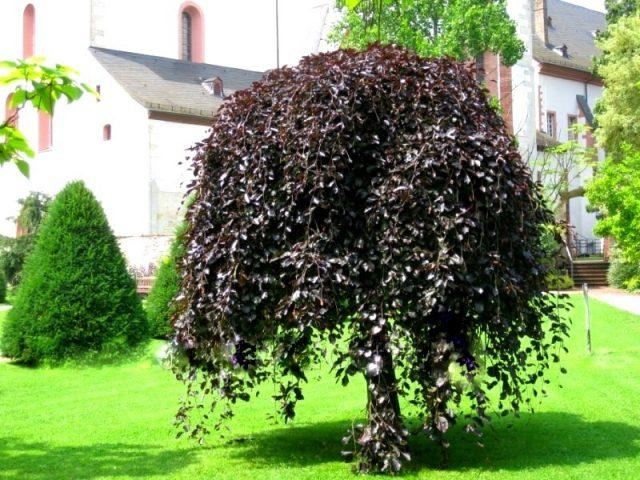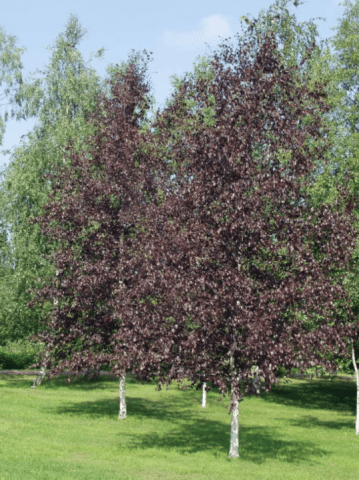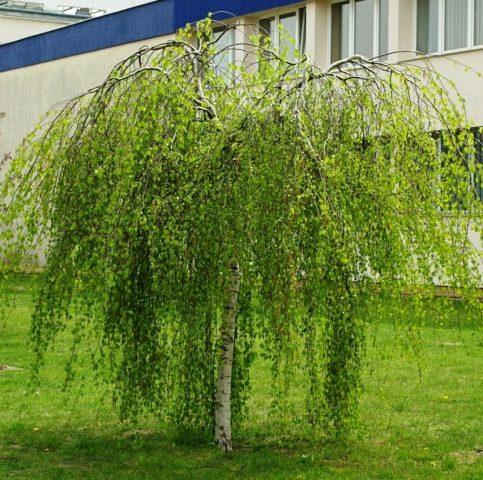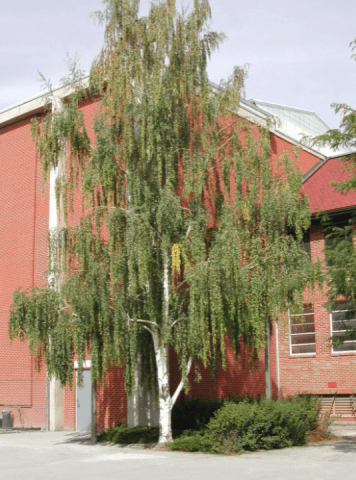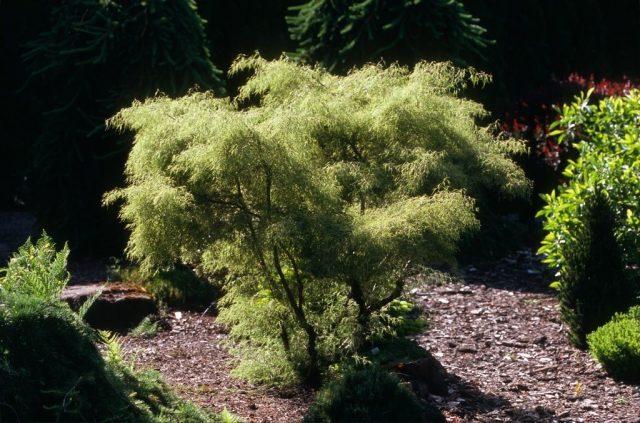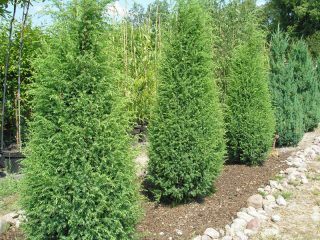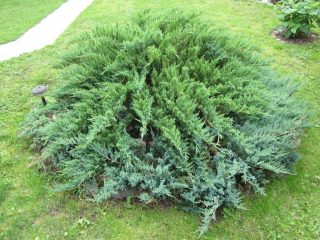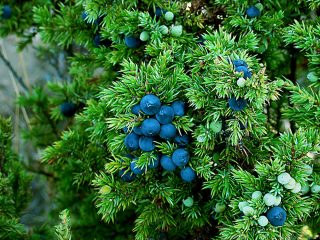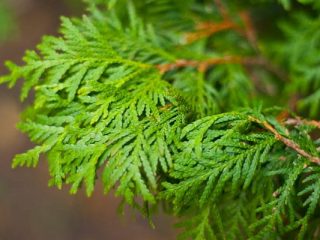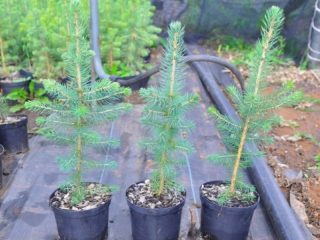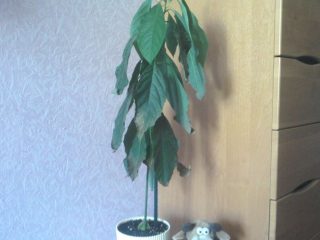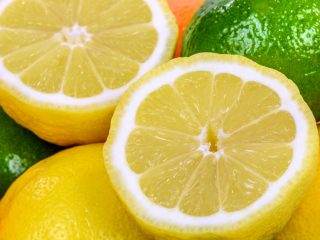Content
Silver birch is a tree that is widespread in natural conditions and is actively used in landscape design. Despite the objective simplicity of appearance, it looks very graceful and elegant. Silver birch requires minimal care; it is able to grow and develop normally, maintaining its decorative appearance, practically without “outside help.”
Botanical description of silver birch
Silver birch (Betula pendula) is a species of deciduous tree that belongs to the family and genus of the same name. It is popularly known by the nicknames “warty”, “crying” and “hanging”. Until recently, silver birch was officially called white (the Latin name is Betula Alba), but in order to avoid confusion with downy birch, they decided to change the names of both types of plants.
The height of an adult tree is 25-30 m. The crown of the plant is relatively sparse, 7-12 m in “girth”.The trunk diameter of silver birch reaches 80 cm.
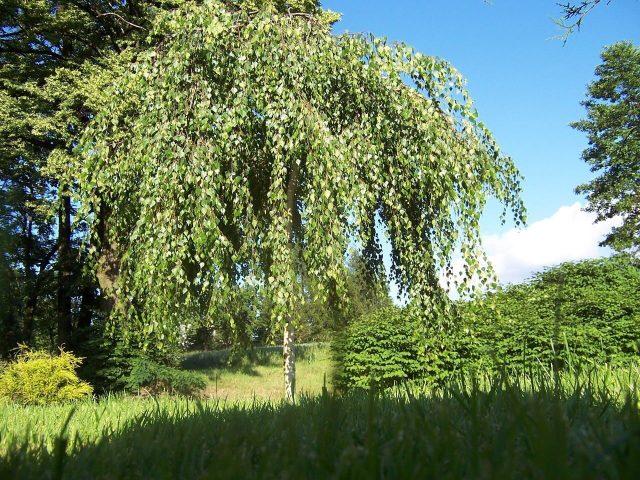
The shoots are quite thin, intensively branching, drooping at the ends
The bark acquires a characteristic recognizable color by the age of 8-10 years. Only at this age does the plant begin to produce in sufficient quantities the specific phytohormone betulin that is “responsible” for this. In young plants, its shade is brownish-beige; a non-specialist can easily confuse them with alder. Contrary to the old name "white", the bark is not snow-white, but rather off-white.
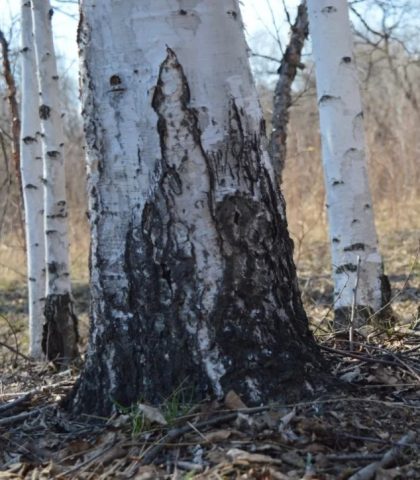
The bark is covered with multiple black-gray cracks, the depth of which increases at the base of the trunk and as it ages.
The leaves of the plant are relatively small, 4-7 cm long. The shape is rhombic-ovate, with a pointed tip and jagged edges.
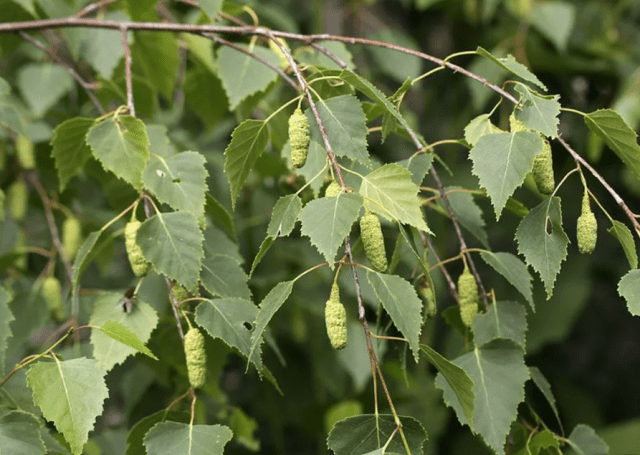
Young leaves are sticky to the touch and become smooth as they grow.
Characteristics of silver birch
Silver birch is not only an ornamental plant, actively used in landscape design. Its “scope of application” is much wider. This is partly due to the prevalence of the plant.
Winter hardiness of silver birch
In terms of cold resistance, silver birch is slightly inferior to downy birch. However, an indicator of up to -30-32 °C is sufficient for most Russian regions. The frost resistance of the “original” is also inherited by the varieties bred by breeders. Even if plants freeze in winter, it is mainly the annual growth that suffers; they do not affect the wood, only the bark. During the season, the plant quickly recovers; in the future, the damage does not affect its decorative effect.
Life expectancy of silver birch
From the point of view of botanists, this species and varieties cannot boast of a long life expectancy. On average, this figure is estimated at 100-120 years. Very few trees, growing in exceptionally favorable climatic conditions, “step over” it.
Silver birch blooming
The specific flowering period depends on the climate in the region and the variety. It occurs from mid-April to the end of the first ten days of May. First the plant blooms, then the leaves bloom.
A characteristic feature of silver birch is its dioecious flowers, collected in inflorescences called “earrings”. Brownish “male” ones appear on the branches in the fall and remain overwintering in the crown. The brighter greenish “female” ones form in the spring.
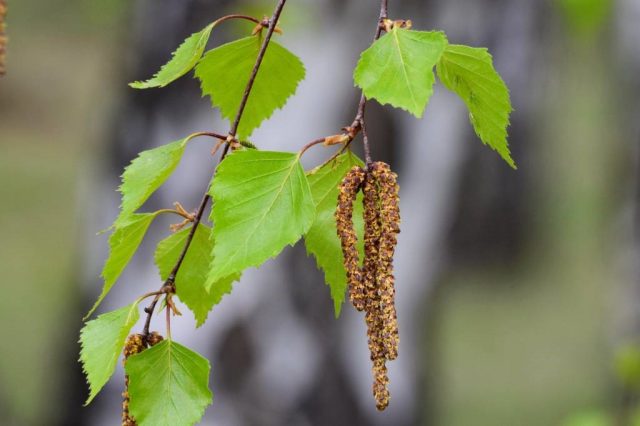
The wind transfers pollen from the “male” flowers of the plant to the “female” ones.
In nature, silver birch begins to bear fruit at the age of ten years, in “captivity” - much later, from 20-25 years. Its fruits are brownish small flattened “nuts” with two “wings”. Regardless of the variety, they ripen in late summer or early autumn.
Where does silver birch grow?
The habitat of the silver birch is very wide. According to this criterion, it is ahead of all other species. The tree is found almost everywhere in North America and Europe, Western and Central Asia. It is grown as an ornamental crop in South America and South Africa.
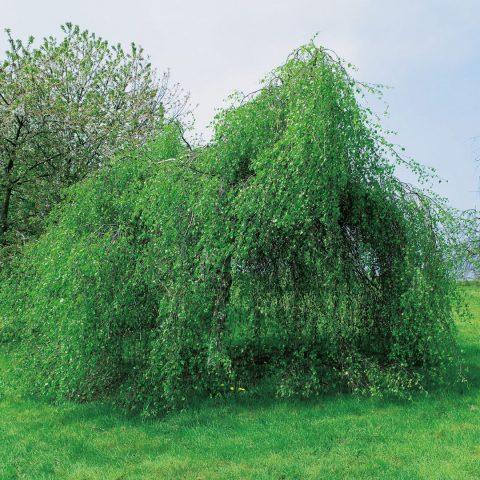
In Russia, silver birch cannot be found only in the Far North and the Black Sea region
Accordingly, the plant’s habitat in the north is limited to the tundra, and in the south – to the tropics. It can “rise” in height to 2100-2500 m above sea level.
Application of silver birch
In addition to planting in “public areas” and personal plots for their “improvement”, silver birch is widely used in everyday life, industry, folk and official medicine:
- the juice is drunk in its pure form, the leaves and flowers are dried, and teas are brewed;
- almost all parts of the plant have healing properties, the same applies to the chaga mushroom growing on it;
- wood is a raw material for the production of birch tar, activated carbon, charcoal pencils and crayons for artists, carbon filters, turpentine, cellulose, plywood;
- birch firewood of any type is characterized by increased heat transfer, therefore it is in great demand;
- In folk crafts, burl and plant wood are the basis for completely unique decorative items; baskets are woven from branches, and dishes are made from birch bark.
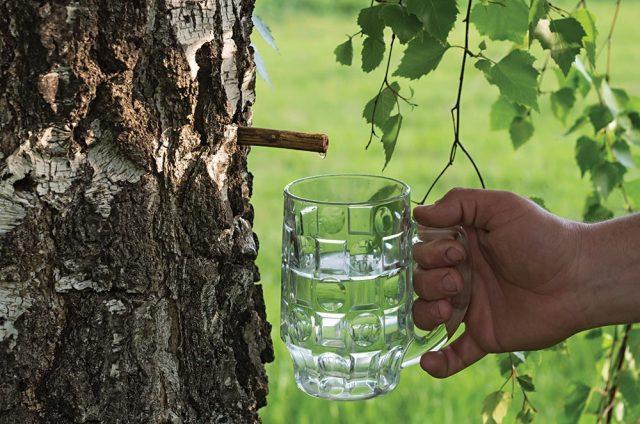
Birch sap is a product with a clearly expressed “seasonality”
Varieties of silver birch
Breeders have developed quite a lot of varieties based on silver birch. Popular among gardeners are:
- Purpurea. The tree is low (up to 10 m), slowly growing. The diameter of the cone-shaped crown is a maximum of 4 m. The bark is grayish. The leaves of the variety are almost diamond-shaped, the color changes during the season from dark scarlet to purple-burgundy.
When there is a lack of light, the leaves of the Purpurea variety change color to natural green
- Royal Frost.Height up to 9 m, crown wide-pyramidal. The bark of this variety is bronze on young shoots, and almost snow-white on mature shoots. The leaves are burgundy, thin. Maintains shade in partial shade.
The Royal Frost variety adapts to soil of almost any quality, but the plant does not tolerate a polluted atmosphere
- Youngii. The variety is grown mainly on a trunk; the plant height reaches 4-5 m. The crown is sparse and umbrella-shaped. The ends of the shoots hang down, touching the ground, they require regular pruning. The leaves are triangular.
The Young variety has a fast growth rate, adding up to 1 m per season
- Gracilis. The variety stands out for its very elegant, “openwork” crown. The height of the tree reaches 10 m, it grows extremely slowly - in 20 years up to a maximum of 5 m. The leaves are small, thin, light green, with deeply indented edges.
Gracilis variety is superior to others in cold and drought resistance
- Trost's Dwarf. A dwarf variety up to 1.5 m high and up to 1.8-2 m in diameter. The leaves of this species are strongly dissected, the shape is something between a maple and a fern.
Variety Trosts Dwarf - a multi-stemmed tree that looks more like a bush
Planting silver birch
In fact, silver birch has two requirements for the planting site - good lighting and the absence of groundwater close to the surface. The plant successfully takes root in substrate of almost any quality, including very “poor” sandy and highly acidified soils.
When planting, it is necessary to take into account the dimensions of the crown of an adult tree of a particular variety. About 5 m is left between neighboring silver birch specimens. The distance to any obstacle should be the same. The plant can be planted both in autumn and spring at a temperature of about 10 °C.
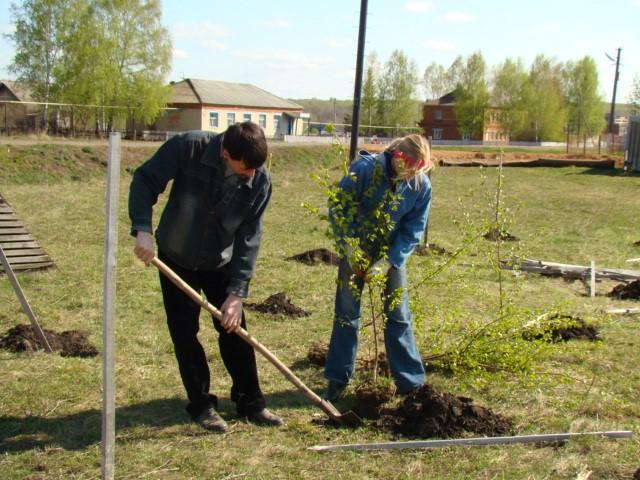
It is advisable to add organic and mineral fertilizers to the planting hole.
Care instructions
You will have to devote time and effort to caring for silver birch mainly during the first season after planting it. The necessary activities are limited to the following:
- Watering. In the first year after planting - once a week or a week and a half, if there is no rain. Then the plant will make do with melt water and precipitation.
- Feeding. Not required, but recommended. In the spring, silver birch is watered with a solution of mineral nitrogen fertilizer; closer to mid-autumn, a complex product is applied. If the substrate is very “poor”, annually or once every 2-3 seasons in the spring it is recommended to incorporate humus or ready-made compost into the soil under the plant.
- Trimming. In natural silver birch, the crown is formed without “outside help”; here it is better to limit yourself to sanitary pruning of the plant at the beginning and end of the season. In varieties bred by breeders, pruning is carried out in the fall to give the crown an “unnatural” appearance.

Fertilizers applied in the fall should not contain nitrogen.
How does silver birch reproduce?
Silver birch successfully reproduces by self-seeding. Most gardeners resort to this same method. The germination rate of freshly harvested seeds is 85-90%, but drops quickly. Therefore, they are planted in the fall, immediately in the chosen place or in a “cold” greenhouse or hotbed.

The main thing is that the area for sowing is well illuminated by the sun.
The furrows are made 1.5-2 cm deep and sprinkled with a thin layer of mulch on top.In spring, seedlings appear quite early. At the end of May or early June, plants from the greenhouse or greenhouse can be moved to a permanent place.

A birch tree formed from growth on a stump can be easily distinguished by the presence of several trunks, as if diverging from one point
Diseases and pests
The experience of growing trees by gardeners suggests that diseases for them are an extremely rare occurrence. The only exception is powdery mildew, which at an early stage of development manifests itself in the form of a pale gray or whitish coating on the leaves. Gradually it becomes denser and darker.
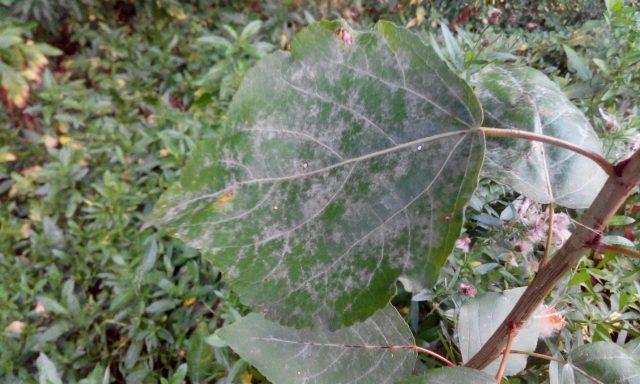
The tissues under the layer of plaque dry out or rot, holes form on the leaves
Fungicides will help to cope with powdery mildew on the plant. Silver birch and the soil in the tree trunk circle are processed in strict accordance with the manufacturer's instructions. This is especially true for the frequency of spraying and preparing the solution.
In addition, tinder fungi can parasitize the trunk. Unlike the chaga mushroom, which forms a symbiosis with wood, their mycelium, growing into wood, damages it. Therefore, the “body” of the mushroom is cut off, the resulting “wound” is washed with a 2% solution of copper sulfate and covered with garden pitch.
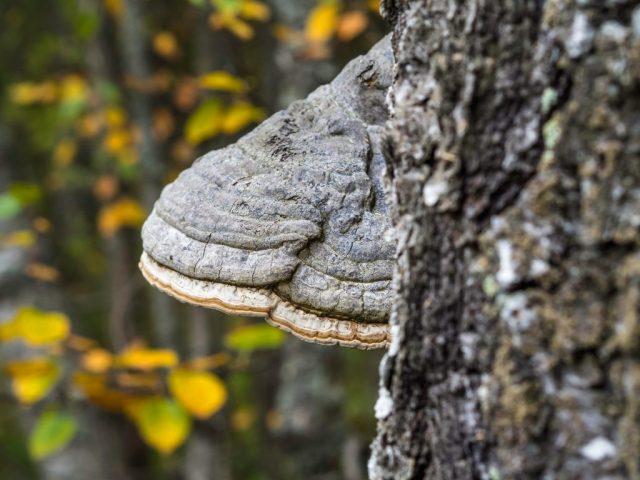
The tinder fungus is a kind of “orderly”; it forms only on sick or otherwise weakened trees
Of the pests for silver birch, the most dangerous are caterpillars of white butterflies, cutworms, hawthorns and others that feed on the leaves.They are very voracious; in a matter of days they leave a “skeleton” of veins from the leaf plate.
To prevent butterflies from laying eggs on the leaves and trunk of silver birch, during the period of their maximum activity it is sprayed with a solution of Lepidocide, Bitoxibacillin. Having discovered caterpillars on a tree, use any universal insecticide.
Application in landscape design
The simplest solution in landscape design is to plant one or several specimens of silver birch against the “backdrop” of a well-groomed green lawn. The plant remains decorative throughout most of the growing season - this is ensured by light bark, unusual early flowering, and bright yellow leaves in the fall.
Growing silver birch on a trunk will add originality to this solution. With the help of targeted crown formation, you can further emphasize the “weeping” branches.
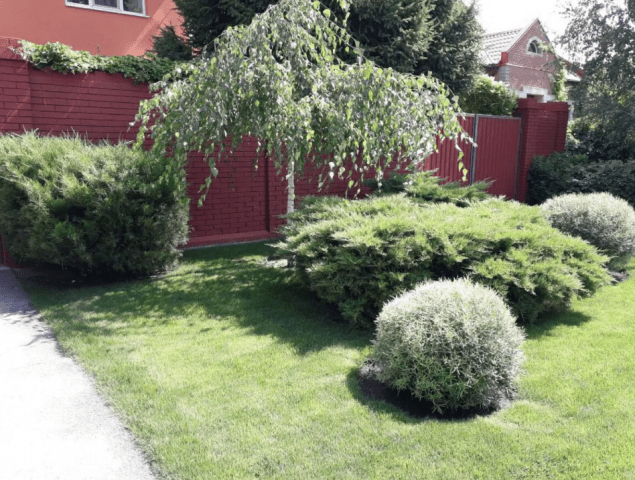
In general, the tree tolerates “haircuts” well, so the crown can be given a bizarre configuration
In compositions, silver birch is most often combined with coniferous trees and shrubs, distinguished by the rich dark color of their needles. Its leaves and light bark create a spectacular contrast.
Conclusion
Silver birch, formerly known as white birch, is a tree that is consistently “in demand” by amateur gardeners and professional landscape designers. Its popularity is facilitated by breeders developing new varieties with an original appearance and leaf color.From the “natural” silver birch they “inherit” very good cold resistance and ease of care; accordingly, any of them can be recommended even to inexperienced gardeners.
